Aerodynamics in gravel? We must be crazy right? I can promise you we are not. If you understand the basics of aerodynamics for gravel you may just afford yourself bragging rights over your buddies because you saved yourself minutes at your next race.
It’s true, even most pros are not using aerodynamics to their advantage in gravel cycling but I ask that you read this email with an open mind. If you learn the basics, you will be a faster gravel cyclist.

Aerodynamics and Mechanical Efficiency
Remember from last month, your goal is to be a faster cyclist, outsmart your competitors, and improve your mechanical efficiency. Aerodynamics burns watts in both heat and sound making it one of the largestwatt wasters. Improve your aerodynamics by using more of the watts you put into the pedals to move you forward, ultimately, making you faster.
Aerodynamics 101
Have you ever stuck your hand outside the window of a moving car? (If not, try it out, you don’t know what you’re missing) That’s the simplest visual for aerodynamics. When your palm is down, your hand moves through the air easily – low drag. When you turn your palm forward, your arm quickly gets pushed to the back- high drag. The key to aerodynamics is to reduce your drag in all ways possible. In cycling, your body is the largest form of drag. Reducing drag saves watts and makes you faster.
The Largest Aerodynamic Drag Producers for Gravel Cyclists
Here’s a list of the top three items to optimize to reduce your aerodynamic drag:
- Bike fit
- Wheels & Tires
- Helmet
Aerodynamic Myths
Aerodynamics doesn’t apply to gravel: Just because you aren’t riding a tri bike you, haven’t magically avoided the laws of physics. Truth is, aerodynamics applies to all humans on earth. When aerodynamics are optimized, the watt savings are the same for a triathlete and a gravel cyclist. 11 watts!
Weight: Some believe that weight is as important or more important than aerodynamics. Maybe because it’s something you can see and measure, but the “lighter is faster” old wive’s tale has persisted. Truth is, weight differences have little to do with time. If you want to get technical, weight matters most getting up to speed when trying to overcome inertia. However, even when we studied heavy aero wheels and super light box rim wheels on courses with vertical change, Aero wheels win every time. In gravel, once you get up to speed, there isn’t a lot of starting and stopping, so there is little to no benefit to a lighter wheel.
Wheel Depth: If you are coming from triathlon or road cycling you will likely be familiar with the belief that only experienced cyclists can handle deep wheels. Truth is, good wheel design will allow you to enjoy a deeper aerodynamic wheel. Back in the day, wheels were designed to be aerodynamic but not stable. Crosswinds were scary! Today, we focus on aerodynamics and stability in the design process. We will throw away the fastest aero wheel if stability sucks.
Wheels and Aerodynamics
Great wheels can save you minutes at your next gravel race. All FLO wheels are designed to greatly reduce your drag aka be super aero. Back in the day, we developed a computer that mounted on a bike that collected real world aerodynamic data. We learned that cyclists have a limited range of yaw angles in which the aerodynamics matter most. We then used that data to create a custom algorithm and developed rim shapes that are fast where it matters.
For gravel cyclists, wheel selection is based more on your terrain than anything. 9 times out of 10, gravel cyclists choose the G700 wheel set.
Wheel 1 on 1
While we’ve only scratched the surface of aerodynamics but these basics will give you more knowledge than 95% of your competitors. If you’d like to discuss aerodynamics in detail and learn how to optimize your wheels for your next gravel race feel free to book a Wheel 1 on 1.

Co-founder at FLO Cycling. Jon manages the day to day operations and acts as the lead engineer for all FLO products.
